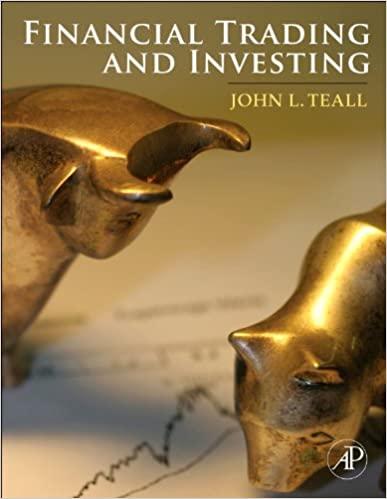Question
Vitality Inc. Gregory Armishaw is an equity analyst specializing in the food and beverage industry at Fulsom-Wagner Investment Counsel in Minneapolis, Minnesota. In late January
Vitality Inc.
Gregory Armishaw is an equity analyst specializing in the food and beverage industry at Fulsom-Wagner Investment Counsel in Minneapolis, Minnesota. In late January 2014, he became aware of a new salt substitute, SansSalt, that was developed by a local company, Vitality FoodGroup, Inc. (NYSE listing: VFG).
With the continuing concern over health matters arising from excessive salt use, Armishaw believes that the addition of this product line could be quite beneficial to VFG. He uses the data in Exhibit 1 to calculate the value of VFG using (1) the residual income model and (2) the H-model version of the dividend discount model.
| Exhibit 1 Vitality FoodGroup Selected Information for Valuation, 31 December 2013 | |
| Net Income | $422 million |
| Common Stock (par plus paid-in-excess of par) | $1,075 million |
| Retained earnings | $1,078 million |
| Weighted average cost of capital | 11.9% |
| Cost of debt, before tax | 7.0% |
| Cost of equity capital | 15% |
| Expected dividend growth behavior: |
|
| Expected for 2014 | 14% |
| After 2014, dividend growth rate declines linearity over a 6 year period |
|
| The final and perpetual growth rate: | 5% |
| Estimated earnings per share (EPS) in 2019 | $5.04 |
| Dividend payout ratio | 40% |
| Shares outstanding | 150 million |
Armishaw shows his report to Anthony Stack, Fulsom-Wagners senior portfolio manager and Armishaws reporting official. In the H-model calculation, Stack notices that Armishaw assumes a sustainable growth rate of 5% following the period of high growth. Stack asks Armishaw if it is true that the sustainable growth model assumes the company will require
1. External debt financing
2. External equity financing, and
3. Improving return on equity.
Still concerned with the estimate of growth after2019, Stack asks Armishaw what the present value of growth opportunities (PVGO) will be in 2019 when the perpetual growth period begins.
Armishaw next presents exhibit 2 which contains his basis for his estimates for the share price (as of January 15, 2014) if he assumes a terminal value in 2023 arising from treating 2023s residual income as a perpetuity.
| Exhibit 2 Vitality FoodGroup Basis for Terminal Value and Revised Price Estimate, 15 January 2014 | |
| Forecasted residual income (RI) per share at end of 2023 | $5.32 |
| Estimated return on equity (ROE) in 2023 | 20% |
| Nature of stream beyond 2023 | perpetuity |
| Growth rate beyond 2023 | 0% |
| Cost of equity | 15% |
| Dividend payout | 40% |
Stack questions Armishaws assumption in his 2014 valuation (Exhibit 2) that a perpetuity would best describe the terminal value of the stream and suggests that residual income should fade over time. Stack further suggests that a persistence factor of 0.50 might be appropriate.
Stack tells Armishaw that he prefers the use of a residual income model to value the company over other available methods. He provides three justifications for his preference:
1. The model explicitly incorporates the cost of debt capital.
2. The model can be used when cash flows are unpredictable.
3. There is less of an impact arising from the uncertainty in forecasting terminal value.
ANSWER ALL THE FOLLOWING QUESTIONS BY WRITING ONLY THE CORRECT CHOICE.
Question 1 of 6
Based on the information in Exhibit 1, Armishaws estimate of VFGs residual income per share for 2015 is closest to:
A. $1.17
B. $0.84
C. -$0.28
Question 2 of 6
Based on the information in Exhibit 1, the H-model per share valuation of VFGs common shares is closest to:
A. $17.89
B. $14.85
C. $15.86
Question 3 of 6
Which of Stacks three assumptions regarding the sustainable growth rate model is most accurate?
A. 2
B. 3
C. 1
Question 4 of 6
The most appropriate answer to Stacks question about the PVGO is:
A. -$12.43
B. $19.32
C. -$13.44
Question 5 of 6
Using the information in Exhibit 2 and comparing Armishaws approach to terminal value with Stacks approach, Stacks assumption leads to a 2023 value that, in current dollars, is approximately:
A. $26.30 higher than Armishaws approach
B. $6.74 lower than Armishaws approach
C. $6.50 lower than Armishaws approach
Question 6 of 6
The least appropriate justification that Stack makes in support of the use of the residual income model is statement:
A. 1
B. 3
C. 2
Step by Step Solution
There are 3 Steps involved in it
Step: 1

Get Instant Access to Expert-Tailored Solutions
See step-by-step solutions with expert insights and AI powered tools for academic success
Step: 2

Step: 3

Ace Your Homework with AI
Get the answers you need in no time with our AI-driven, step-by-step assistance
Get Started


